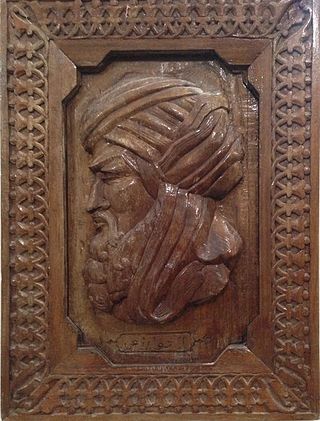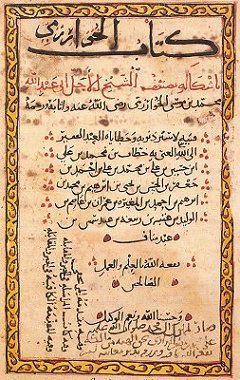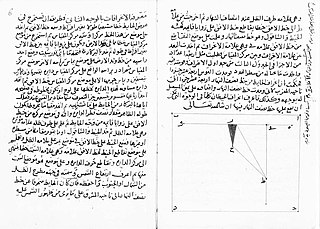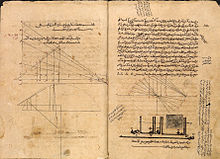Thābit ibn Qurra, was a polymath known for his work in mathematics, medicine, astronomy, and translation. He lived in Baghdad in the second half of the ninth century during the time of the Abbasid Caliphate.
Abū al-Ḥassan, Aḥmad Ibn Ibrāhīm, al-Uqlīdisī was a mathematician of the Islamic Golden Age, possibly from Damascus, who wrote the earliest surviving book on the use of decimal fractions with Hindu–Arabic numerals, Kitāb al-Fuṣūl fī al-Ḥisāb al-Hindī, in Arabic in 952. The book is well preserved in a single 12th century manuscript, but other than the author's name, original year of publication and the place (Damascus) we know nothing else about the author: after an extensive survey of extant reference material, mathematical historian Ahmad Salīm Saʿīdān, who discovered the manuscript in 1960, could find no other mention of him. His nickname al-Uqlīdisī was commonly given to people who sold manuscript copies of Euclid's Elements.

Muhammad ibn Musa al-Khwarizmi, often referred to as simply al-Khwarizmi, was a Persian polymath who produced vastly influential Arabic-language works in mathematics, astronomy, and geography. Hailing from Khwarazm, he was appointed as the astronomer and head of the House of Wisdom in the city of Baghdad around 820 CE.

Abū ʿAbd Allāh Muḥammad ibn Jābir ibn Sinān al-Raqqī al-Ḥarrānī aṣ-Ṣābiʾ al-Battānī, usually called al-Battānī, a name that was in the past Latinized as Albategnius, was an astronomer, astrologer and mathematician, who lived and worked for most of his life at Raqqa, now in Syria. He is considered to be the greatest and most famous of the astronomers of the medieval Islamic world.

Abu al-Saqr Abd al-Aziz ibn Uthman ibn Ali al-Qabisi, generally known as Al-Qabisi,, and sometimes known as Alchabiz, Abdelazys, Abdilaziz, was a Muslim astrologer, astronomer, and mathematician.
Muhammad ibn Ibrahim ibn Habib ibn Sulayman ibn Samra ibn Jundab al-Fazari was an Arab philosopher, mathematician and astronomer.

Kamal al-Din Hasan ibn Ali ibn Hasan al-Farisi or Abu Hasan Muhammad ibn Hasan ) was a Persian Muslim scientist. He made two major contributions to science, one on optics, the other on number theory. Farisi was a pupil of the astronomer and mathematician Qutb al-Din al-Shirazi, who in turn was a pupil of Nasir al-Din Tusi.

Mahmūd ibn Muḥammad ibn Umar al-Jaghmini or 'al-Chaghmīnī', or al-Jaghmini, was a 13th or 14th-century Arab physician, astronomer and author of the Qanunshah a short epitome of by Avicenna in Persian, and Mulakhkhas (Summary), a work on astronomy.

Mathematics during the Golden Age of Islam, especially during the 9th and 10th centuries, was built on Greek mathematics and Indian mathematics. Important progress was made, such as full development of the decimal place-value system to include decimal fractions, the first systematised study of algebra, and advances in geometry and trigonometry.

Medieval Islamic astronomy comprises the astronomical developments made in the Islamic world, particularly during the Islamic Golden Age, and mostly written in the Arabic language. These developments mostly took place in the Middle East, Central Asia, Al-Andalus, and North Africa, and later in the Far East and India. It closely parallels the genesis of other Islamic sciences in its assimilation of foreign material and the amalgamation of the disparate elements of that material to create a science with Islamic characteristics. These included Greek, Sassanid, and Indian works in particular, which were translated and built upon.

The Hindu–Arabic numeral system is a positional base ten numeral system for representing integers; its extension to non-integers is the decimal numeral system, which is presently the most common numeral system.
The three brothers Abū Jaʿfar, Muḥammad ibn Mūsā ibn Shākir ; Abū al‐Qāsim, Aḥmad ibn Mūsā ibn Shākir and Al-Ḥasan ibn Mūsā ibn Shākir, were Persian scholars who lived and worked in Baghdad. They are collectively known as the Banū Mūsā.
Ibrahim ibn Sinan was a mathematician and astronomer who belonged to a family of scholars originally from Harran in northern Mesopotamia. He was the son of Sinan ibn Thabit and the grandson of Thābit ibn Qurra. Like his grandfather, he belonged to a religious sect of star worshippers known as the Sabians of Harran.
This is a timeline of pure and applied mathematics history. It is divided here into three stages, corresponding to stages in the development of mathematical notation: a "rhetorical" stage in which calculations are described purely by words, a "syncopated" stage in which quantities and common algebraic operations are beginning to be represented by symbolic abbreviations, and finally a "symbolic" stage, in which comprehensive notational systems for formulas are the norm.
The Golden Age of Islam, which saw a flourishing of science, notably mathematics and astronomy, especially during the 9th and 10th centuries, had a notable Indian influence.
Na‘īm ibn Mūsā was a mathematician of the Islamic Golden Age and a pupil of Thabit Ibn Qurra. Na'im was from Baghdad and lived in the second half of the 9th century. He was the son of Muḥammad ibn Mūsā ibn Shākir, the oldest of the three brothers Banu Musa.
Ali ibn Sulayman al-Hashimi, known as al-Hashimi, was an Islamic astronomer and mathematician, who flourished during the late 9th century.

ʿAbū ʿAlī al‐Ḥusayn ibn Muḥammad al‐Ādamī was a maker of scientific instruments who wrote an extant work on vertical sundials, Techniques, Walls, and the Making of Sundials. The manuscript, which is held in the Bibliothèque nationale de France, contains tables that enabled the drawing of lines to show any desired angle of latitude. The surviving copy of al-Adami's 10th century manuscript (Arabe 2506,1 dates from the 15th century, which King has suggested was written either by al-Adami or by a contemporary, Sa'id ibn Khafif al-Samarqandi. The tables on folios. 31v–33v were intended to be used in the construction of a vertical sundial.
Yusuf al-Khuri, also known as Yusuf al-Khuri al-Qass, was a Christian priest, physician, mathematician, and translator of the Abbasid era.










